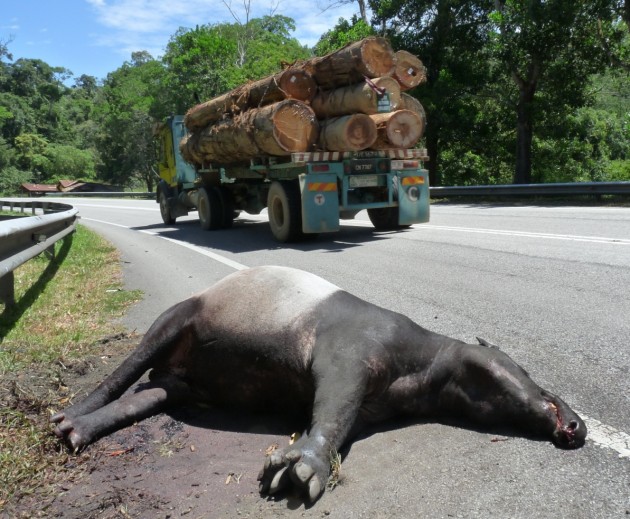By John Barrat
For tropical lizards that bask at night on warm rocks, a paved roadway might seem the perfect spot to repose for an hour. Bad idea. Anteaters with poor eyesight, slow-moving sloths, and the Australian echidna—whose reaction is to freeze in the path of oncoming vehicles—are some of the many rainforest species that are particularly vulnerable to becoming roadkill.
Vehicle-animal collisions are just one of many ways that rainforests are degraded when roads, highways, utility lines and other linear clearings are built across them, say biologists William Laurance, Miriam Goosem and Susan Laurance in a recent paper published in the journal Trends in Ecology and Evolution. The Laurances are tropical biologists at the Smithsonian Tropical Research Institute in Panama, and all three authors are researchers at James Cook University in Australia.

Photo: Road building for oil development in the rainforests of Gabon, central Africa. (Photo by William Laurance.)
The authors use dozens of existing studies done in the Amazon, Australasia and Central Africa to emphasize that roads are the number one threat to the world’s tropical rainforests. Maintaining large, roadless areas of intact forests should be highest priority of conservationists worldwide, the scientists urge. They also offer practical measures to mitigate the damage of existing, new and planned roadways in tropical countries. “Determining the locations of future highways and roads in countries with tropical rainforests will be the greatest single factor in influencing future forest loss, fragmentation and degradation,” the authors point out. “In broad terms, roads can be thought of as the enemies of rainforests.”
New logging roads make forests greatly more accessible to exploitation by hunters, miners and settlers. Disease and invasive species generally follow the influx of humans. “By spreading people out across the forest, roads inherently promote rapid and widespread deforestation,” the authors write.
Whenever a clearing is created in a rainforest the humid, dark and stable microclimate of the forest’s interior is altered deep into the forest surrounding the clearing’s edge. Building a long, linear road disturbs thousands of acres of forest along both sides of the roadway. For many specialized forest animals roads are barriers to resources and migration. Others, attracted to the roadway, risk being killed.
Today, tropical rainforests are located mainly in developing nations, many of which are which are being rapidly transformed by population growth, development and intense pressure from other countries for their natural resources. Road building is exploding in these countries, destroying tropical forests at a rate of 50 football fields a minute.
To help mitigate the impact of roads and other linear projects in the world’s rainforests, the authors make these recommendations:
- Write environmental impact assessments for new roads that take into account the true impact of a new road in terms of forest invasions, hunters, land speculation and secondary road building;
- Establish protected reserves along new roadways before roads are built;
- Minimize new roads created by logging operations with careful pre-harvest planning and focus logging operations along existing highways and already-populated areas;
- Limit the widths of logging roads and close the roads after logging is completed in a region;
- Build roadways with proper drainage that can handle the intense runoff from heavy tropical rainfall;
- Promote the building of railroads over roadways;
- Allow secondary growth and vines to proliferate along forest margins, providing a buffer that lessens forest desiccation and wind;
- Try to maintain a relatively continuous forest canopy above roads and build artificial canopy walkways over roadways for arboreal species;
- Establish wildlife fences to steer animals toward culverts built to allow safe passage under roadways; and
- Limit vehicle speeds, use speed bumps and warning strips and restrict night-time driving when animal activity is highest.
“Actively limiting frontier roads,” the biologists conclude, “is by far the most realistic, cost-effective approach to promote the conservation of tropical nature and its crucial ecosystem services.
“Given the central role of roads in promoting tropical deforestation and atmospheric carbon emissions, we assert that forest carbon-trading initiatives should often focus explicitly on limiting and mitigating frontier roads. Such efforts might be more feasible than many realize.”








